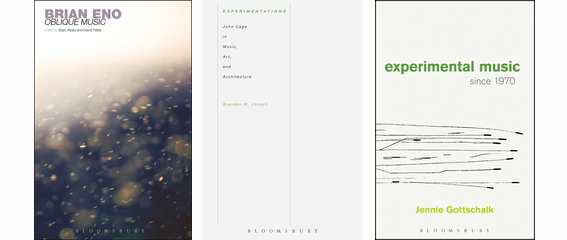Experimentations. John Cage in Music, Art, and Architecture. Branden W. Joseph
(217pp, Bloomsbury Academic, 2016)
Experimental Music since 1970, Jennie Gottschalk
(292pp, Bloomsbury Academic, 2016)
Brian Eno. Oblique Music, eds. Sean Albiez and David Pattie
(282pp, Bloomsbury Academic, 2016)
There are several problems with academic writing. Despite good academic writing aspiring to be clear, lucid and readable, academic books – often rejigged or hastily rewritten PhD submissions – sometimes fall short of these aspirations. Specialism is another problem: those immersed in, say, electro-acoustic music, avant-garde jazz, or contemporary classical music, sometimes seem oblivious to other genres or areas of music and what’s going on in them. All too often something is written about as radical or innovative, when it’s actually an import or hybridisation of something that has previously happened elsewhere.
John Cage, of course, does not deserve to be pigeonholed in this kind of way, and the title of Branden W. Joseph’s book suggests the author is aware of this, and Cage’s genre-bending and genre-breaking body of work, his collaborations, responses, philosophies and acceptance of what is/was produced as the result of chance operations and the world around him/us. Whilst ‘Chance, Indeterminacy, Multiplicity’ is the subject of chapter 4 here, Joseph falls prey to academic gobbledegook rather than the simplicity Cage aspired to. What, for instance, is one to make of a phrase such as ‘[Buckminster] Fuller presented spatial expansiveness more as an imperative than an option’ (p83) or ‘By apparently replacing an individual at the center of the socioeconomic system, the traditional musical work functions to relieve, if only temporarily, the anxieties experienced by the subject decentered by the development of capitalism.’ (p119)?
There is far too much of this kind of thing among more readable and interesting discussion. Joseph starts by locating Cage within an avant-garde performance tradition, setting him up in opposition to Allan Kaprow, placing him a lineage with Marcel Duchamp, then considers Cage’s adoption of Eastern traditions and philosophies through architecture and space before moving to ‘The Architecture of Silence’ and the multimedia performance HPSCHD which Cage created with Lejaren Hiller. Joseph’s idea is to discuss the first three decades of Cage’s work and his move from an established avant-garde position, with an established lineage, to a more original and all-embracing philosophical umbrella under which new and innovative work could be established or discovered.
Indeterminacy and silence are two of the terms Jennie Gottschalk uses to define features of experimental music in the opening chapter of Experimental Music Since 1970. She then goes on to use a number of differing approaches such as scientific development, physicality, audience perception, sound as language, place and time, to explore a vast, wide-ranging number of musical examples from all sorts of genres and areas, including sound poetry, improvisation, field recording, performance art, jazz, as well as contemporary composition, electro-acoustic music, and contemporary classical. Whilst there are always omissions in books like this, musicians or works one wishes were mentioned, this is more than compensated for by the lucid and engaging discussion of so much music new to me, which has had me scurrying to youtube, download sites and the library to find examples. Gottschalk’s book is enthusiastic, highly readable and does not attempt to be too definitive in its explorations.
Sean Albiez and David Pattie’s book about Eno is the least academic of the three titles reviewed here (perhaps because of the potential wider audience for its subject?) and it’s all the better for that. Don’t get me wrong, the essays or chapters in this anthology are thoughtful, thought-provoking, informed and interesting, but they come at their subject from an appropriately wide-ranging and inter-disciplinary number of fields. I must confess that I am the co-author of one of these chapters, a chapter designed – by its use of appropriation, collage and remix – to question the way academia relies on quotations as much as explore it’s subject of collaboration and Eno’s Oblique Strategies cards.
Elsewhere, other writers discuss Eno’s emergence in Roxy Music, ideas of non-musicianship, ambient music and Eno’s use of voice, his approach to the studio, and how, if he does, he fits into ‘the experimental tradition’. That’s Part One in a nutshell; in Part Two, Eno’s work as a producer and collaborator is considered, with chapters discussing Eno’s use of the studio, Eno’s relationship with Devo, U2 and African music, and how he documented No Wave, as an ‘urban ethnographer’. It’s a lively and varied collection, that leaves room for even more consideration of the elusive, enigmatic and influential Eno.
© Rupert Loydell 2016

